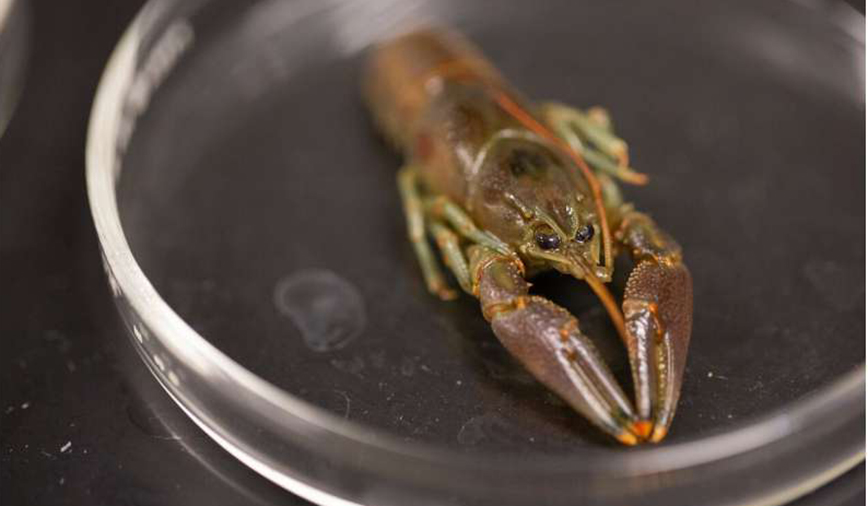September 21, 2012
Did you ever have one of those days where you’ve found yourself feeling a little, well, rusty?
I have, more than I care to think of. In fact, I’d wager that I’ve felt a little rusty just about every day over these past few weeks; worse, I don’t see the trend stopping, not next week or even the week after that.
Why?
Right now, as part of the St. Charles Park District’s nature education outreach, we’re teaching wetland ecology at Otter Creek Bend Wetland Park. During September, more than 800 District 303 fifth graders will take part in the program, which includes hands-on activities in the marsh, where it’s pretty dry this year, and in the creek, where it’s wet—though markedly less so than in previous years.
I’ll admit, it’s been awhile since been I’ve been out there in the front lines, rubbing elbows with our Specifically, rusty crayfish, or Orconectes rusticus.
fabulous team of talented program instructors. I’ve flubbed a
line or two as I’ve led the kids through the intricacies of the
water cycle and the transfer of energy in food webs; I’ve
scratched my head really hard to recall the differences
between narrow-and broad-winged damselfly nymphs; and
I’ve had to reacquaint myself with the creek’s morphology—
that is, where the big rocks and deep pools lie—so that
neither the kids, teachers nor I go tumbling tukas-over
teakettle in the water.
But these challenges account for only a small part of my rusty
feeling. The biggest reason is…
Crayfish. dark, rusty-red spots, one on either side of
the carapace. Their placement makes it
looks as though someone dipped his or her
1 fingertips in rusty-red paint, then picked up the crayfish. No other crayfish species
has these distinctive marks.
Every day we net at least a few, sometimes several and, occasionally, many of these pugnacious, introduced little devils from beneath the rocks and logs strewn along the creekbed. I’ve felt a little rusty, which measured around 2 in. in length, and I’ve felt a big rusty, a 4-incher that gave a nasty pinch. I’ve also felt a lot of rusties in between. So have our instructors, and hundreds of fifth graders too.
The rusty crayfish, an aquatic invader native to the Ohio River watershed, first appeared in Illinois in 1973 when unknown anglers emptied their bait buckets into Peoria Lake on the Illinois River. Subsequent accidental releases combined with the species’ own aggressive tendencies have led to robust rusty crayfish populations in waterways throughout northern Illinois.
Now you might be inclined to think, “Gee, Ohio isn’t that far away. How could a species ‘Made in America’ be a problem just a few hundred miles from its native range?”
Short and sweet, rusty crayfish are thugs. They’re the bully on the playground and the obnoxious party guest that won’t go home, all rolled into one hard-shelled, pincer-waving package.
Rusty crayfish eat more, grow more quickly and reproduce more rapidly than our native species. When threatened, they are more likely to rear up and raise their claws than to scoot quietly away—the preferred exit strategy of most Illinois crayfish. Confronted with such a display, most fish and even some turtles will back down and head off in search of more easily subdued prey.
What’s more, rusties are messy eaters. When they feed on aquatic plants—items that also happen to be on the menu of our native crayfish, plus many other critters—they don’t just nibble daintily. Nope. Rusties rip the plants up by the roots, eat their fill and leave the rest to rot. This sort of strategy not only ruins the food source for other plant eaters, but also changes the habitat itself. Less aquatic-plant cover means fewer hiding places for insects and small fish, and less stabilization of stream or pond’s substrate, which in turn leads to greater erosion, increased siltation and further degradation of the habitat.
I’d love to be able to say that there’s an easy fix for this rusty problem in our water. But, as is the case with so many introduced species, there’s no clear-cut solution. There are, however, steps you can take to help curtail the rusties’ spread:
Get to know what rusty crayfish look like (see photo)
Don’t use rusty crayfish as bait.
Don’t transport crayfish of any species between bodies of water.
Don’t release that classroom crayfish your star student brought home from school. Even if it’s not an O. rusticus, chances are good it wasn’t raised around here and therefore shouldn’t be let go here either.
Review these tips as needed, and feel free to contact me with any questions you might have. Because the last thing we want is for you to let you your crayfish management skills to get, well… rusty.

